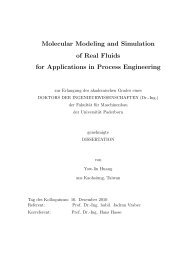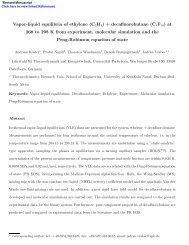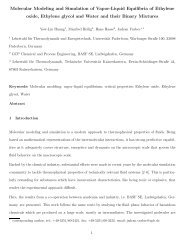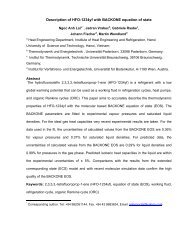ms2: A Molecular Simulation Tool for Thermodynamic Properties
ms2: A Molecular Simulation Tool for Thermodynamic Properties
ms2: A Molecular Simulation Tool for Thermodynamic Properties
You also want an ePaper? Increase the reach of your titles
YUMPU automatically turns print PDFs into web optimized ePapers that Google loves.
motion, kinetic energy calculation, atom to molecule trans<strong>for</strong>mation and vice versa. Furthermore, this branch<br />
is responsible <strong>for</strong> the initialization. It reads the molecular model <strong>for</strong> every component, calculates positions,<br />
introduces the reduced quantities etc.<br />
The second branch deals with interactions between molecules of the same or different type. There<strong>for</strong>e, it contains<br />
all <strong>for</strong>ce and potential energy calculations, which are the computationally most expensive parts by far. This<br />
branch is highly vectorized to achieve a fast calculation, in particular if executed in vector-parallel. The modules<br />
in this branch are simulation technique specific, i.e. MD or MC. In a MD simulation, first, the interaction partners<br />
of every molecule are determined, i.e. other molecules or sites within the cut-off radius. Then the interaction<br />
energies and virial contributions as well as the resulting <strong>for</strong>ces and torques are calculated and summed up <strong>for</strong><br />
every molecule.<br />
In a MC simulation, the modules are designed to calculate only the energy and the virial. Forces are not evaluated<br />
and the corresponding algorithms are there<strong>for</strong>e entirely omitted in these modules. For MD, all interactions<br />
of one component-component pair are calculated in one call of the module. For MC, the modules are finer-<br />
grained, calculating all interactions of one component-component pair by determining every molecule-molecule<br />
interaction individually. The corresponding modules are thus called more frequently than in case of MD.<br />
Fifth level - molecule. The basic in<strong>for</strong>mation on a molecular model is stored on this level, such as mass, moment<br />
of inertia tensor, rotational degrees of freedom etc. Higher level modules access these data via the class molecule.<br />
Sixth level - site. Here, the assembly of a molecule is stored. The data are used by higher level modules to<br />
determine the site positions from the molecular positions and orientations. This allows <strong>for</strong> the calculation of<br />
site-site interactions. It should be noted that<strong>ms2</strong> only integrates (MD) or accepts (MC) center of mass positions<br />
and orientations. Site specific data are calculated <strong>for</strong> every simulation step on the fly.<br />
5.2. Parallelism<br />
The source code is implemented <strong>for</strong> an efficient parallelism with distributed memory, using the MPI [64] standard<br />
<strong>for</strong> communication. The program uses the following MPI calls:<br />
• MPI Init, MPI Finalize, MPI Comm rank, MPI Comm size to set up basic MPI functionality<br />
• MPI Abort to stop the program in case of an error<br />
• MPI Barrier, MPI Wtime and MPI Wtick within the stopwatch class<br />
• MPI Bcast, MPI Reduce, MPI Allreduce <strong>for</strong> simulation data exchange<br />
Exclusively collective communication is used, an approach suitable <strong>for</strong> molecular simulations, where the cut-<br />
off radius is in the order of the simulation volume edge length. For MD simulations with <strong>ms2</strong>, only the <strong>for</strong>ce<br />
calculation is parallelized using molecule decomposition according to Plimpton [14]. The interaction matrix<br />
is rearranged such that the number of interaction partners is almost equally distributed in the matrix. This is<br />
achieved by calculating the interactions between molecules 1 and N as interactions between molecules N and<br />
19








